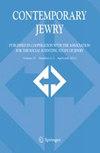美国犹太牧师:采用美国形式
Q1 Arts and Humanities
引用次数: 0
摘要
本文首次对美国犹太牧师进行了全面的研究。像美国所有宗教背景的成员一样,越来越少的犹太人有宗教信仰,经常加入或参加当地的教会,犹太人和其他美国人可能会在教会生活之外找到解决他们精神宗教需求的方法,比如在医院、军队、大学、老年人护理和其他“生活发生”的环境中。牧师是在这些环境中工作的宗教专业人士。虽然很多人都做过牧师的工作——照顾他人,照顾临终者,帮助人们参与精神上的生存斗争——但那些认为自己是犹太牧师的人的进化,以及他们与牧师这个词(本身就是基督徒)的斗争,是本文提供的分析的中心。我们从一个简短的历史概述开始,然后描述他们今天的工作。我们的分析基于2021-2022年进行的一系列历史和社会学调查。面对主要是新教的规范和对牧师的期望,美国犹太人——他们组成了第一批在国家和私人场所成为牧师的非基督教神职人员——已经参与并改变了牧师的概念和胜任这些职位所需的培训。犹太牧师的案例说明了如何在美国生活中寻找犹太人的缝隙。本文章由计算机程序翻译,如有差异,请以英文原文为准。
American Jewish Chaplains: Adopting an American Form
Abstract This article represents the first field-wide treatment of American Jewish chaplains. As fewer Jews, like members of all religious backgrounds in the USA, are religiously affiliated and regularly join or participate in local congregations, Jews and other Americans will likely find ways to address their spiritual–religious needs outside of congregational life, in settings such as hospitals, military, universities, elder care, and other settings where “life happens.” Chaplains are religious professionals who work in these settings. While many people have done the work of chaplains—caring for others, attending to the dying, helping people engage with their spiritual–existential struggles—the evolution of those who consider themselves Jewish chaplains and their wrestling with the term chaplain, itself Christian, is at the center of the analyses offered here. We begin with a brief historical overview and then describe their work today. Our analysis is based on a series of historical and sociological inquiries carried out in 2021–2022. In the face of largely Protestant norms and expectations that shaped chaplaincy, American Jews—who made up the first non-Christian clergy to become chaplains in state and private settings—have engaged with and shifted the concept of chaplaincy and the training required to be eligible for these positions. The case of Jewish chaplains illuminates ways of navigating the seams of Jewishness in American life.
求助全文
通过发布文献求助,成功后即可免费获取论文全文。
去求助
来源期刊

Contemporary Jewry
Arts and Humanities-Religious Studies
CiteScore
0.80
自引率
0.00%
发文量
57
期刊介绍:
Contemporary Jewry serves as the single source for the social scientific consideration of world Jewry, its institutions, trends, character, and concerns. In its pages can be found work by leading scholars and important new researchers from North America, Europe, Australasia and Israel. While much relevant scholarship about Jewry is published in general social science journals, as well as more narrowly focused periodicals, no single scholarly journal focuses primarily on the social scientific study of Jewry.Over 500 articles have been published in Contemporary Jewry since its inception. Each issue includes original research articles across a variety of social-science disciplines, including anthropology, demography, economics, education, ethnography, social history, politics, population, social psychology, and sociology. We are open to submissions of shorter research notes, and, on occasion, will publish important work that had originally appeared in Hebrew or other languages. Special issues have focused on such topics as the National Jewish Population Survey, Jewish community surveys, Ultra-Orthodox Jews, Women in the Holocaust, economic frameworks for understanding Jewry, and Jewry in Israel. Individual articles have treated a range of topics, from Jewish identity in Syria and the Ukraine to New Zealand and Israel; from an analysis of rabbis’ salaries to a historical study of Jewish women physicians in Central Europe; from survey research to ethnography to historical analysis. Each year Contemporary Jewry includes the Marshall Sklare Award lecture, delivered at the Association of Jewish Studies conference in co-sponsorship with the Association for the Social Scientific Study of Jewry, the founding association of the journal, by distinguished scholars chosen to receive the award because of their contributions to the field of the social scientific study of Jewry. The distinguished editorial board reflects the multi-disciplinary nature of the journal.Comments or discussion of any of the content in COJE is welcome at http://COJE.forums.com.
 求助内容:
求助内容: 应助结果提醒方式:
应助结果提醒方式:


